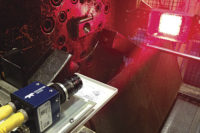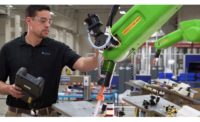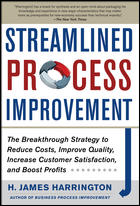
A smart camera combines a digital camera, processing, software and communications in a small package. Source: Dalsa Corp.
Smart cameras combine a digital camera, processing, software and communications in a small package. They are an excellent choice for a machine vision system to do tasks such as gaging or visually detecting part defects. Currently, there are several types of machine vision systems that are commonly used for quality control.
Three Types of Machine Vision Systems
A vision sensor is appropriate for simple vision tasks, such as detecting when a part is present. Vendors such as Banner, Omron and Keyence offer a variety of sensors that measure things such as International Commission on Illumination (CIE) color or depth at a point on an object. Sensors make one type of measurements at one or a few points. They require little or no programming so are easy to setup.Most machine vision tasks require multiple measurements on two- or three-dimensional images and so require significantly more intelligence than a simple sensor. These tasks are typically solved by a combination of vision processing functions and therefore require some programming.
Machine vision tasks that are difficult, fast or require significant computational power are best done by a PC-based machine vision system. An example of a difficult task is detecting low-contrast defects such as scratches, bubbles, discolorations, burn marks or contamination. These types of defects are poorly defined so extensive computation is required to detect them.
Smart cameras are appropriate for the many machine vision tasks that require two- or three-dimensional imaging and have moderate computation and speed requirements. Dimensional gaging, verifying a part’s outline, barcode or optical character recognition (OCR), defect detection and locating parts (perhaps to guide a robot), are examples of tasks that can be done quickly and inexpensively by a smart camera.
Some vendors call their smart cameras “sensors” perhaps to emphasize that they have limited programmability and thus should be easy-to-use. An example of a smart camera often called a sensor is a dedicated barcode reader.

PC-based machine vision systems and smart cameras require programming because they are general-purpose tools. Source: Dalsa Corp.
Riding the Mobile Computing Curve
Most smart cameras use a digital signal processor (DSP) for their intelligence. Some smart cameras also use processing elements similar to that in advanced cell phones or other mobile computing devices. These processing elements include a standard central processing unit (CPU), hardware image processors and a capable DSP.A smart camera that uses mobile computing technology has a number of advantages. First, the demand for smarter mobile devices with ever-better features drives increases in processor performance. The smart camera can ride the mobile computing performance curve for increased speed or to take on more demanding vision applications.
Second, the inclusion of a standard CPU means familiar operating systems and machine vision software can be used. If more performance is needed, it is easy to migrate to a PC-based system running the same machine vision software.
Third, mobile computing devices are very low power and fit into small packages.
Some smart phone applications have a machine vision component. For example, one can get an appplication for a smart phone that reads a bar code which connects to reviews of that product. Also, some cell phone cameras locate faces in an image to set the color balance and exposure. However, industrial machine vision requires hardware and software not found in a smart phone. Besides, who would want to wash-down their smart phone?
It's the Software
PC-based machine vision systems and smart cameras require programming because they are general-purpose tools. If the programming takes too much time, the need and money for a machine vision project evaporates. Easy-to-use software is therefore required for rapid and successful development of a machine vision application.Modern machine vision software allows you to program your vision application graphically-point-and-click to select a tool, such as a caliper, and then position that tool on the part to be measured. There is no programming in the usual sense. Vision operations are presented in familiar terms, rather than the terms of machine vision algorithms. For example, the caliper tool is presented as if it was a mechanical gage so there is no need to understand sub-pixel edge detection algorithms.
New smart cameras are designed to be servers on an Ethernet network and have no way to display images themselves. Instead, images are sent over the Ethernet to a client PC. Here a technician can set up and program the smart camera from the client PC and then log off of the smart camera and let it run independently. Results are reported over Ethernet using standard industrial protocols or via digital input/output lines from the camera. One client PC can manage many smart cameras.

Parts from a vibratory bowl go into an index wheel that rotates to show the part to the smart camera for dimensioning. Note the protective enclosure around the smart camera's lens. Source: Prime Engineering
A Working Example
Prime Engineered Components (Watertown, CT) manufactures 800,000 precision-turned parts per week for automotive, aerospace and other industries. Defective parts cause expensive returns and hurt customer relations. Using smart cameras, Prime is doing 100% quality inspection with nearly zero part defect escapes.One Prime facility manufactures mostly screw machined parts-parts with grooved patterns such as threaded anchor bolts. Critical dimensions for these parts include the minimum and maximum dimensions of the threads.
To measure these dimensions, the parts are fed by a vibratory feeder into slots on an index wheel. The wheel turns to position the part in front of the smart camera and a caliper tool measures the thread dimensions.
Defective parts are manually removed from the product stream. It might seem odd to have automated the handling and visual inspection of the parts but not defect sorting, but the defect rate is low and Prime examines defective parts to correct the production process. Once again, easy-to-use software for the smart camera was the key to getting this inspection task built.
The convergence of smart mobile devices and machine vision allows small, fast and inexpensive machine vision systems that are perfect for many machine vision tasks. How about having the smart camera e-mail or tweet your smart phone when there is a problem?


